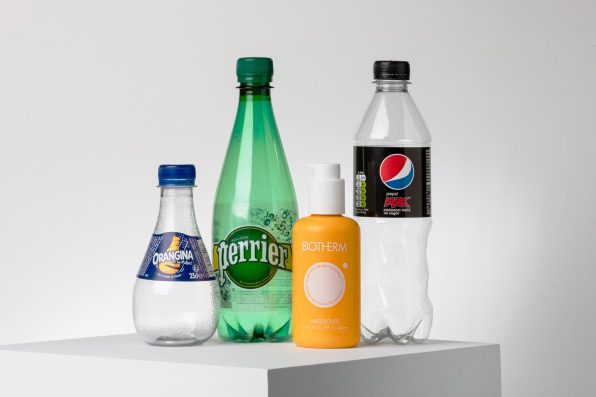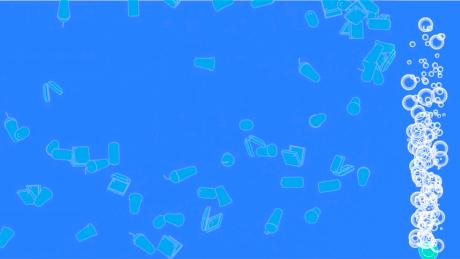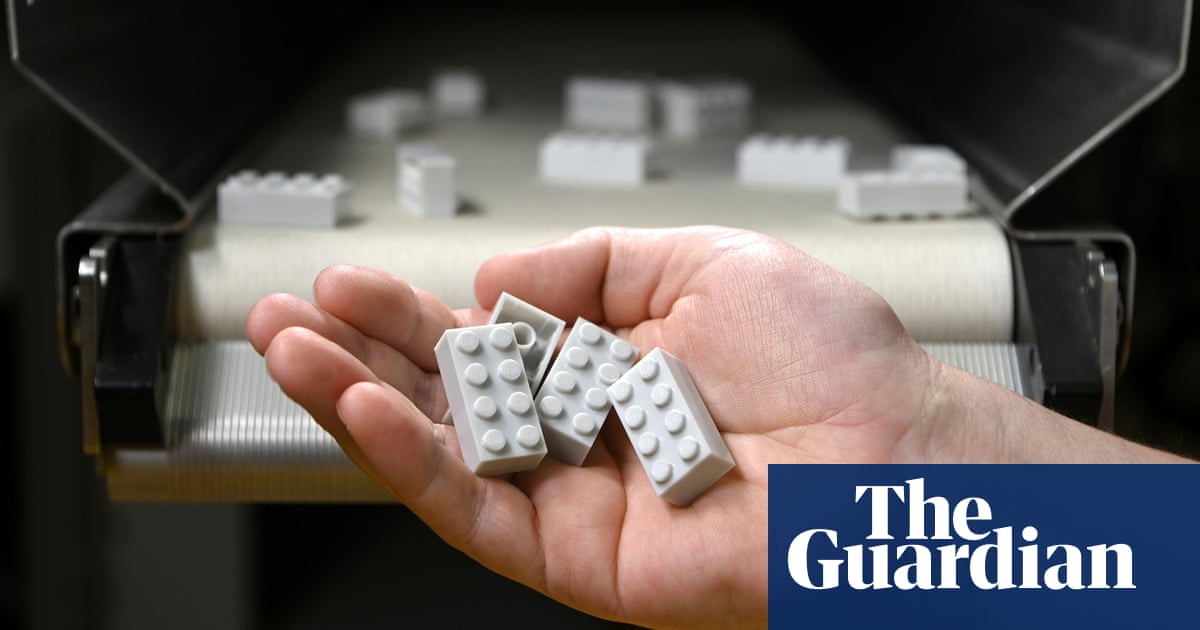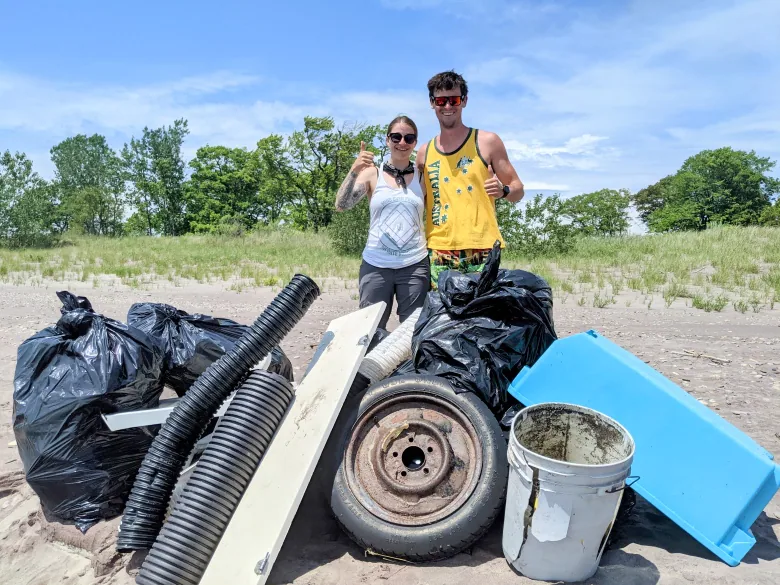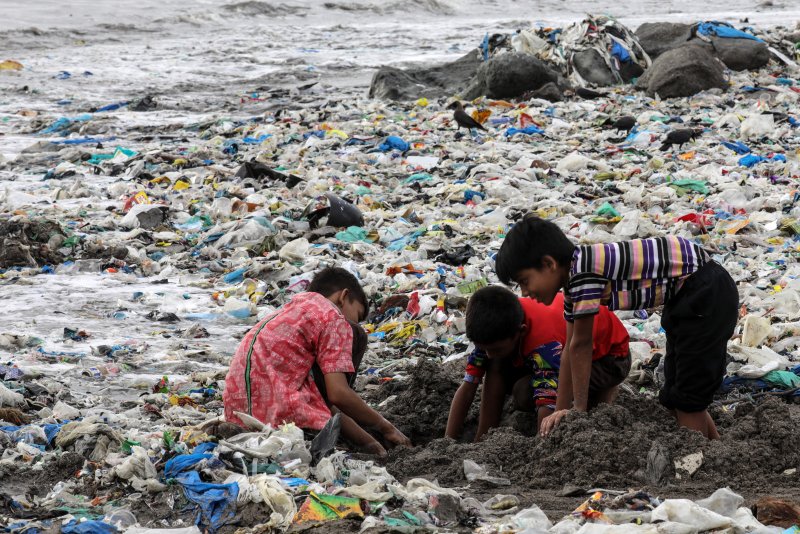Category Archives: News
These bottles are made from plastic recycled by enzymes
The enzymes break down plastic to the molecular level, making it easier to use different kinds of plastics to make new bottles.
[Photo: Jérôme Pallé/courtesy Carbios]
By
Lego found a way to build its bricks out of recycled plastic
A single one-liter bottle can be recycled into material for around 10 standard two-by-four Lego bricks.
[Photo: Lego]
By
Drones are helping to clean up the world's plastic pollution
The problem is so far-reaching it’s hard to know where to start cleaning it up. But UK-based startup Ellipsis Earth believes it can help. Using drones fitted with cameras, Ellipsis maps the location of plastic pollution. Through computer software and image recognition, it’s then able to identify the type of plastic, its size, and in some cases, even the brand or origin of the trash. This data can be used to inform solutions.Ellipsis uses image recognition software to map trash. (courtesy Ellipsis Earth Ltd)”We would be able to find out that ‘Beach X’ has a ton of fishing nets and discarded lobster traps, whereas ‘Beach Y’ has a ton of hygiene and sanitation wet wipes,” says Ellie Mackay, Ellipsis founder and CEO. For the Beach X scenario, “we need to speak to the fishing industry and get some regulation around dumping of ghost nets,” she tells CNN. Whereas for Beach Y, “it’s about educating people not to flush things down the toilet and speaking to local sewage outlets.”The technology allows Ellipsis to carry out a survey in a matter of minutes — much faster than the typical method on foot. Mapping the worldThe startup, which was officially founded in 2019 following several years of research and development, has undertaken projects all over the world — from the UK coastline to the banks of the Ganges river in India. The project that hit home most for Mackay was in the Galapagos Islands, roughly 620 miles off the coast of Ecuador. “There are coastlines there that have not changed since [Charles] Darwin set foot on those beaches, all those years ago,” she says. “The only difference — the only evidence that man exists — is in the plastic all over the beaches.”Data gathered by Ellipsis in 2017 and 2018 found that on one of the most remote beaches in the area, you are never more than 43 centimeters (17 inches) away from a piece of trash, says Mackay. But such shocking data has led to action. Since the Ellipsis baseline survey, Mackay says that Galapagos authorities have introduced a ban on single-use plastics, including Styrofoam takeaway containers and plastic bags, across the archipelago. While the majority of plastic that washes up on the islands’ shores comes from elsewhere (most of the islands are uninhabited and the population is only around 25,000), the ban extends to tourists and service providers. Another Ellipsis project based in Sorrento, Italy, surveyed cigarette butt littering, leading to an education campaign and more strategic placement of bins and ashtrays across the town. According to Ellipsis, the campaign has resulted in a 70% reduction in cigarette littering.Meanwhile, the startup’s ongoing project in Bournemouth, UK, will inform the local council of trash hotspots, so that it can provide extra bins or alter street cleaning schedules. Richard Thompson, professor of marine biology and director of the Marine Institute at the University of Plymouth in the UK, says that this solution-based approach to gathering data is vital.While there is plenty of evidence to prove that plastic pollution exists worldwide, there is still a lack of targeted data that can be used to inform effective solutions, he says.Tech evolutionThe use of aerial imagery to map plastic pollution is not new. Thompson recalls a time before drones, when scientists experimented with sending up balloons with cameras attached to take aerial photos of beaches. More recently, the European Space Agency used satellites to identify plastic pollution. “But what’s happening here is that the technology for drones and also the image resolution has improved quite substantially over time, making it much more viable,” says Thompson.Mackay agrees. “Drones are a game changer for environmental monitoring. They allow us to survey an entire stretch of coastline … in a few minutes,” she says, adding that Ellipsis technology can automatically detect 47 categories of trash items with more than 95% accuracy.However, there are limits to what the Ellipsis technology can detect. Microplastics — plastic particles smaller than five millimeters, of which at least 14 million metric tons are estimated to be sitting on the ocean floor alone — cannot be identified.But Mackay argues that by focusing on tracking and mapping larger plastic items they are helping to solve the problem at its root. “If you collect one plastic bottle, that’s 25,000 potential microplastic pieces in the future,” she says. Thompson believes this is the right approach. He says the majority of plastic entering the ocean is in the form of bigger waste items that later break down. “That’s really the place where you want to intervene and the place where you want the data. It’s far simpler to count and identify the microplastics of the future,” he says, adding that different techniques will be required to quantify plastic particles — such as microbeads from cosmetics — that are already small when they enter the environment.Ultimately, Mackay’s goal is not to stop the use of plastic altogether — she recognizes what an “amazing” and useful material it is — but rather to improve management of it. “By mapping trash around the world, we’ll be able to target our solutions effectively,” she says, creating a “lasting impact through behavior change and education, (so) that we’ll be able to minimize the amount of mismanaged waste.”#video_1606835203041{margin:20px 0;}#video_1606835203041 video,#video_1606835203041 img{margin: 0; position: relative; width: 100%;}.cap_1606835203041{-webkit-font-smoothing:antialiased;padding:0 0 5px 5px; font-size:16px; color:#595959;}.cap_1606835203041:before{content:””;display: block;height: 1px;margin-top: 10px;margin-bottom: 10px;width: 80px;background-color: #C5C5C5;}.cap_1606835203041 >span{color:#C5C5C5;}@media(orientation:landscape){.video_1606835203041{display:block;}.Mvideo_1606835203041{display:none;}}@media(orientation:portrait){.Mvideo_1606835203041{display:block;}.video_1606835203041{display:none;}}
Lego develops first bricks made from recycled plastic bottles
Lego has unveiled its first bricks made from recycled plastic bottles and revealed that it hopes to include the pieces in sets within two years. The Danish company, which takes its name from the Danish words for “leg godt”, meaning “play well”, makes billions of bricks a year, most of them from a plastic called …
Continue reading “Lego develops first bricks made from recycled plastic bottles”
The plastics you throw away are poisoning the world's eggs
Eggs eaten by some of the world’s poorest people are being poisoned by plastic waste from rich countries like Canada and the U.S., new research has found. A suite of harmful chemicals are added to plastic and food packaging to give them desirable traits, like grease resistance or flexibility. When they burn or break down, these chemicals contaminate the surrounding environment and animals living or feeding nearby.Chickens can absorb the chemicals by drinking contaminated water or eating contaminated worms and insects. Eggs are particularly sensitive to containing toxic chemicals and are commonly consumed by people, according to the report produced by the International Pollutant Elimination Network (IPEN), a global coalition of environmental organizations. Get top stories in your inbox.Our award-winning journalists bring you the news that impacts you, Canada, and the world. Don’t miss out.The problem is most acute for people in low- and middle-income countries at the receiving end of the multibillion-dollar global trade in plastic and electronic waste. According to the recent study, which was not peer-reviewed, people eating free-range eggs raised near 25 plastic waste dumps and recycling centres in 14 low- and middle-income countries are exposed to levels of toxic chemicals far beyond safe limits to human health. “I’m really impressed,” said Max Liboiron, a professor of geography at Memorial University who specializes in plastic pollution. (Liboiron was not involved in the research.) “These folk are looking at the mixing of plastic and e-waste in the actual conditions that the waste occurs, they’re looking at the way people actually eat eggs … and they’re looking at a range of chemicals (that) exist in the real world.” What people are reading It’s a “really, really rare” approach, Liboiron explained, as most research into the toxicity of plastics only looks at a select few chemicals in a laboratory setting. That can make it difficult to assess the full impact plastic waste disposal and recycling have on human health and the environment. The problem is exacerbated by the chemicals’ tendency to change — and often become more toxic — when exposed to heat, light and other chemicals and metals. “The chemical that goes into plastic isn’t necessarily the same chemical that comes out. It can change when you expose it to air, water, different pH, different salinities,” explained Imari Karega Walker, a PhD candidate at Duke University studying the environmental impact of plastic additives. Those factors can create a suite of chemicals that fly under industry and government safety checks on new plastic products, yet pose a danger to the environment and human health, she said. The IPEN study looked at some of those compounds in its broad assessment of persistent organic pollutants, like carcinogenic dioxins and biphynols produced from burning plastic waste, for instance.The study’s choice to assess recycling sites as well as open landfills is also important, Liboiron noted. For years, the global plastics industry has promoted recycling as a sustainable and safe way to dispose of harmful plastics. The findings point out that those promises may not be accurate. Furthermore, they highlight the ongoing problems arising from rich countries’ waste exports to the developing world. Eggs eaten by some of the world’s poorest people are being poisoned by plastic waste from rich countries like Canada and the U.S., new research by @ToxicsFree has found. #PlasticWaste “A lot of our waste management systems rely on exports … the U.S., U.K., Europe (and Canada) don’t have a functional waste infrastructure,” Liboiron explained. “(We’re) implicated, because it’s quite literally our waste.”Earlier this year, Canada officially entered into the Basel Convention’s plastic agreement, a global treaty restricting the international trade in plastic waste. However, critics have noted that in fall 2020, the federal government quietly signed an agreement with the U.S. to allow the free flow of plastic waste between the two countries. Roughly 93 per cent of Canada’s plastic waste exports go to the U.S., according to data by the Basel Action Network (BAN), an environmental organization. Because the U.S. isn’t a signatory to the treaty, it can export Canadian plastic garbage to poorer countries.Each month, about 25.7 million kilograms of plastic waste — mainly low-quality, unrecyclable plastic of uncertain origin — leaves U.S. shores for countries like Malaysia, Mexico and Vietnam, BAN reports. While countries have in recent years tried to stem some of the flow, which is technically illegal, many have had trouble stopping the import of trash from overseas.In theory, if the receiving country has signed the Basel Convention — as 188 countries have — it can’t accept the waste without a bilateral agreement with the U.S. However, economic pressure and a lack of enforcement can make it nearly impossible to stem the flow, according to a December investigation into the issue. “The whole thing can be understood as waste colonialism,” Liboiron said. “It’s our export of waste to other places, but the reason they import our waste is because of existing colonial legacies where we’ve taken out anything else of value already, and now their most viable choice is to import our (trash).”
Nick Dormon: How can we redesign pill packaging to be accessible and sustainable?
Blister packs were a major innovation when they debuted, but it’s time to acknowledge that they’re hard for some people to open and that they create enormous amounts of waste. There has to be a better way.
[Photos: Anastasiia_Guseva/iStock, khuntapol/iStock]
By Nick Dormon 5 minute
Target will design all its own branded products for circularity by 204
The company will also aim to be fully net zero by the same year.
[Illustration: FC]
By
Biologist estimates helium balloons are ending up in Great Lakes by the hundreds of thousands
The plastic balloons we use to mark some of the biggest milestones in our lives — births, deaths, graduations, homecomings, engagements, gender reveal parties — are ending up in the Great Lakes by the hundreds of thousands, according to an Ontario biologist who spent two weeks gathering trash. Leanne Grieves is a postdoctoral fellow at McMaster University in Hamilton who studies bird behaviour and communication. This summer, she’s been working at Birds Canada at Long Point on the north shore of Lake Erie. “Lake Erie is beautiful and the shoreline is just stunning, especially if you’re on the Long Point peninsula,” she said. “It’s really a glorious place to be.” What wasn’t so glorious, though, was the trash, which became such an eyesore for Grieves that she couldn’t help herself. Hundreds of balloons along 7 km of beach “There is just so much garbage washing up on shore,” she said. “After a couple of days driving up and down to our site, I just thought, ‘This is ridiculous. We have to start cleaning this up.'” Leanne Grieves and Ryan Leys, a fellow biologist, stand in front of a pile of trash they collected over a seven-kilometre stretch of Lake Erie shoreline. The garbage bags are filled with helium balloons.
Study: About 25% of chemicals in plastics are 'substances of potential concern'
June 22 (UPI) — One-quarter of chemicals in plastics are “substances of potential concern,” according to an analysis published Tuesday by the journal Environmental Science & Technology.
Of the roughly 10,500 chemicals in plastic, nearly 2,500, or 24%, are capable of accumulating in living organisms, including humans and animals, and are potentially toxic or cancer-causing, the data showed.
Advertisement
In addition, more than half of these substances are not regulated in the United States, the European Union or Japan, where more than 900 of them are approved for use in food contact plastics, the researchers said.
“These substances are often toxic to aquatic life, cause cancer or damage specific organs,” study co-author Helene Wiesinger said in a press release.
“It is particularly striking that many of the questionable substances are barely regulated or are ambiguously described,” said Wiesinger, a doctoral student in ecological systems design at ETH Zurich in Switzerland, where the research was conducted.
Each year, more than 350 million tons of plastic are produced worldwide, and all of them contain a wide variety of chemicals that may pose a significant risk to people and the environment, according to Wiesinger and her colleagues.
These chemicals include additives, such as antioxidants and flame retardants as well as solvents and other substances used in production — and only a small proportion of these chemicals have been extensively studied, the researchers said.
Still, research suggests that plastic packaging is a main source of organic contamination in food, while phthalate plasticizers and brominated flame retardants are detectable in house dust and indoor air.
Exposure to these substances can have a negative impact on the health of consumers and workers and on ecosystems, while also affecting recycling processes and the safety and quality of recycled plastics.
For this study, the researchers compiled a comprehensive database of plastic monomers, additives and processing aids used in the production and processing of plastics and systematically categorized them on the basis of usage patterns and hazard potential.
They identified approximately 10,500 chemicals in plastic, including 2,489 used in packaging, 2,429 textiles and 2,109 that come in contact with food as part of packaging.
More than 500 of the chemicals are used in toys and medical devices, including 247 in masks.
Of the 10,500 substances identified, the researchers categorized 2,480 substances as substances of potential concern, they said.
Of these, 53% are not regulated in the United States, the European Union or Japan.
In addition, research is lacking for about 10% of the identified substances of potential concern.
The researchers were unable to categorize 4,100, or 39%, of the substances they identified due to a lack of “hazard classifications,” they said.
“Until now, research, industry and regulators have mainly concentrated on a limited number of dangerous chemicals known to be present in plastics,” Wiesinger said.

